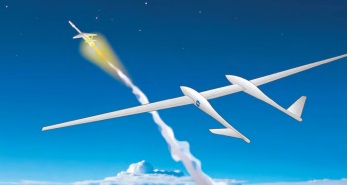Chapter: Hypersonics and Space Technologies, new invention technology, Research project papers,
Air Launch from a Towed Glider

Air Launch from a Towed Glider
This research effort
is exploring the concept of launching a rocket from a glider that is towed by
an aircraft. The idea is to build a relatively inexpensive remotely piloted
glider that could be towed to altitude by a large transport aircraft. The
glider would carry a booster rocket capable of launching payloads into orbit.
After the rocket launch, the glider would return independently of the tow
aircraft to its base to be used again. This
approach could
significantly reduce the cost and improve the efficiency of sending satellites
into orbit.
Work to date: Three separate
technical feasibility studies completed by independent contractors
indicate the technique could achieve significant performance gains over
vertical ground launches of similar-sized rockets. The Armstrong team has
designed and is building a sub-scale research model to test operational aspects
and characterize flight performance and handling qualities. Flight testing and
crew training have begun on a single fuselage glider that will be towed to
altitude.
Looking ahead: Future plans involve continuing
work to assemble a one-third scale glider model with a 24-foot
wingspan to obtain operational experience while under towed flight as well as
performance and handling qualities data. Plans are underway to flight
demonstrate a rocket launch from the sub-scale model.
Partner: Whittinghill Aerospace
is fabricating a rocket for this air launch flight demonstration,
under a Phase III SBIR.
Benefits
More economical: Use of a simple
remotely piloted glider, without the complex propulsion and crew life
support systems required for
a crewed, powered aircraft, provides an inexpensive air-launch
platform.
Increased payload: A towed
glider can carry more than twice the payload of a dedicated powered
aircraft.
Safer: Remotely
piloted gliders that are towed 1,000+ feet behind the tow plane offer a
substantial safety perimeter from the high-energy systems inherent in rocket
boosters (as compared to other air-launch methodologies).
Hypersonics and Space Technologies
Akey objective of hypersonic research at NASA is to develop
methods and tools that adequately model fundamental physics and allow credible
physics-based optimization for future operational hypersonic vehicle systems.
Research focuses on solving some of the most difficult challenges in hypersonic
flight, and Armstrong innovators are contributing to this research in several
ways:
- Exploring adaptive guidance systems
that could detect conditions likely to result in dangerous situations and
automate compensating maneuvers
- Modeling high-altitude environments to
improve flight planning designs for high-speed vehicles
- Designing high-temperature insulative
and advanced composite materials
This research will enable the development of highly reliable and
efficient hypersonic systems.
Related Topics